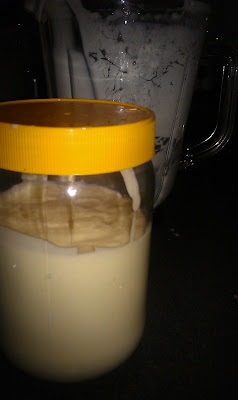 |
| Homemade vegan pompoensoep with crème fraiche |
Take "boterham," for example. To an English speaker, it probably sounds like a combination of butter and pig flesh. However, it's really just the Dutch name for a slice of bread, even if that slice of bread has had no contact whatsoever with either butter or ham. Confusing, right? When a word in one language sounds like a completely different thing in another language, it is called a "false friend."
On the flip side, there are foods like "pompoensoep," which sounds a lot like it's English name - pumpkin soup. Pompoensoep is a linguistic cognate, and it's also no false friend in my growing repertoire of Dutch cuisine. In fact, it has become one of my favorite winter recipes because it's so perfect for the cold and blustery weather in the Netherlands.
So, I'm sharing my recipe for a vegan version of pompoensoep, adapted from this recipe for pompoensoep on albertheijn.com. The original recipe calls for the addition of crème fraiche before serving the soup, so I've thrown in a bonus recipe for vegan crème fraiche, too.
Enjoy!
Vegan Pompoensoep (Pumpkin Soup)
(Serves 4)
Ingredients:
1 small pumpkin, about 1 kilogram, rind and seeds removed, scraped, and chopped into small cubes (reserve the seeds for roasting*)
2 medium carrots (about 150 grams), peeled and diced
1 large onion, peeled and diced
2 cloves garlic, pressed
2 tablespoons olive oil
1 liter (about 4 cups) water
2 bay leaves
1 teaspoon ground cumin
1 vegetable bouillon cube
salt and pepper, to taste
optional: red chili pepper sauce (such as sriracha), to taste
 |
| Chopping up a pumpkin can be hard work! Tip: place a kitchen towel around the pumpkin to prevent it from slipping while cutting. |
1. In a large soup pot, saute the carrot an onion in olive oil for about 5 minutes, until the onion turns translucent. Then add the cumin, garlic, and pumpkin, and saute 5 more minutes.
2. Add the water, bay leaves, and vegetable bouillon, and bring to a boil.
3. Reduce heat and simmer for 30 minutes.
4. Remove the bay leaves, and allow the soup to cool completely before putting it into a blender. You can divide the soup into a couple of large bowls to speed the cooling process, but NEVER put hot soup in a blender!
5. Once the soup has cooled, carefully puree it in a blender in portions. When all of the soup is pureed, return it to the large soup pot, and add the chili sauce, salt, and pepper. Thoroughly reheat the soup over low heat.
6. Before serving, top each bowl of soup with a dollop of vegan crème fraiche (see recipe below) and garnish with a sprig of fresh parsley.
 |
| Roasted pumpkin seeds |
Vegan Crème Fraiche
Note: This recipe makes a lot of crème fraiche, so you could divide it in half if you will only use it as a soup topping. It can be stored in an airtight container in the refrigerator for a few days.
Ingredients:
3/4 cup (180 ml) soymilk
3/4 cup (180 ml) sunflower oil
1 tablespoon lemon juice
1 teaspoon agave syrup (add another half teaspoon if using unsweetened soymilk)
1 teaspoon vanilla extract (optional, but I recommend using vanilla-flavored soymilk if you leave this out)
Instructions:
1. Pour all ingredients into a blender.
2. Blend on medium speed until very thick.
3. Refrigerate in an airtight container until needed.
 |
| Vegan crème fraiche in a repurposed airtight container |



















